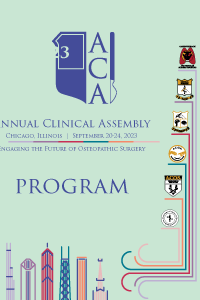General Surgery
Calcium Crisis: The Case of a Giant Parathyroid Adenoma Disguised as Carcinoma
- NA
Neha Aitharaju, OMS
Nova Southeastern University College of Osteopathic Medicine
Miami, Florida, United States
Primary Presenter(s)
Primary hyperparathyroidism (PHPT) is the most common disease of the parathyroid glands, with a prevalence of 22 per 100,000 people, more commonly affecting women [3, 8]. The etiologies of PHPT include adenoma, hyperplasia, and carcinoma, with parathyroid adenomas accounting for 85% of cases [4] (Table 1).
A parathyroid adenoma is typically a benign solitary well-defined tumor of proliferating parathyroid cells. They most often arise sporadically. Some risk factors include previous radiation to the head and neck, chronic hypocalcemia, and multiple endocrine neoplasia [8]. The average weight of a parathyroid adenoma is 1g, while a giant parathyroid adenoma is defined by a weight greater than 3.5 g [4, 8]. Parathyroid adenomas are typically asymptomatic, with hypercalcemia as an incidental finding on routine lab work. The hypercalcemia may present as a mild or moderate elevation, usually less than 1.0 mg/dL above upper limits. PTH (parathyroid hormone) may be mildly elevated or even present within normal limits [8]. Symptomatic parathyroid disease can manifest as hypercalcemic symptoms such as fatigue, bone pain, nephrolithiasis, nephrocalcinosis, ARF, constipation, and neuropsychiatric disturbances [8].
In comparison, parathyroid carcinomas are rare and account for less than 1% of patients with PHPT [7]. Parathyroid carcinomas may present as a palpable neck mass and are strongly associated with hypercalcemic symptoms [7]. Calcium levels are typically 3-4 mg/dL above upper limits [5]. Additionally, PTH levels are markedly increased, often in the thousands as most parathyroid carcinomas are composed of functional tissue [1]. Histological determination can prove to be challenging, therefore, the diagnostic determination relies heavily on intraoperative findings [6]. Gross infiltration of adjacent structures is highly suggestive of carcinoma (Figure 3) [5].
Methods or Case Description:
Patient is a 45-year-old male who was transferred to a community hospital after presenting with worsening generalized weakness, fatigue, ostealgia, and constipation over the course of a few days. Patient’s past medical history includes peptic ulcer disease and nephrolithiasis two years ago.
On admission, the patient had profound hypercalcemia with calcium of 21.0 mg/dL (normal: 8.4-10.2 mg/dL) and hyperparathyroidism with PTH >5000 pg/mL (normal: 7.5-53.5 pg/mL). The patient was in stage 3 acute renal failure (ARF) with blood urea nitrogen 67 mg/dL, creatinine 6.3 mg/dL, and glomerular filtration rate 12 mL/min/1.73m2. Physical exam was notable for a palpable mass on the left anterior aspect of the neck. The single photon emission computed tomography (SPECT) utilizing technetium-99m sestamibi parathyroid scintigraphy revealed abnormal persistent uptake in the left lower parathyroid gland in three-hour delayed images (Figure 1), suggestive of a possible parathyroid adenoma. The patient was admitted for a hypercalcemic crisis in the setting of PHPT. The patient was referred to the surgical team for radioguided neck exploration with intraoperative ultrasound. There was concern for parathyroid carcinoma with potential dissection into the neck due to the overall clinical picture and critical lab abnormalities. Preoperative calcium and PTH levels were 11.9 mg/dL and 2600 pg/mL respectively. The mass was found in the posterior aspect of the left lobe, extending towards the inferior aspect and anterior mediastinum. Typically, the diagnosis of a parathyroid carcinoma is largely clinical. Intraoperatively, the capsule was intact without adherence to surrounding tissue suggesting the low probability of malignancy. Considering that the half-life of PTH is 3-5 minutes, successful excision of any hypersecreting glands can be confirmed intraoperatively. A significant decrease of at least 50% following adenoma removal is expected, otherwise, further exploration is warranted [8]. The intraoperative PTH measurement obtained after the removal was 547 pg/mL. The 80% reduction of PTH confirmed the successful removal of the left inferior hypersecreting parathyroid mass. Following the surgery, the calcium levels decreased to 8.9 mg/dL. Gross pathologic examination showed a well-circumscribed, thinly encapsulated, red-tan hemorrhagic nodular mass weighing 22g and measuring 4.5 x 3.5 x 3cm (Figure 2A). The outer surfaces were gray-tan and smooth with no papillary excrescences. The specimen was inked in green and serially sectioned to reveal a solid and partially cystic hemorrhagic well-circumscribed mass with a yellow discoloration. Histologic evaluation of frozen sections revealed a benign proliferation of dense adenomatous tissue consisting of chief and oxyphil cells with markedly decreased intercellular fat and rare intact rim of normal parathyroid tissue (Figure 2B). There was no diagnostic histological evidence of malignancy, reconfirming the clinical diagnosis of parathyroid adenoma. Based on the patient’s clinical presentation, which included hypercalcemic crisis with calcium 2x upper limit, PTH 100x upper normal limit, a palpable neck mass, and ARF secondary to PHPT, there was a strong suspicion for parathyroid malignancy. However, the intraoperative findings did not show any signs of local tissue invasion, and the histological findings reaffirmed this conclusion. As a result, the diagnosis of parathyroid carcinoma was ruled out.
Outcomes:
Conclusion: Encountering such profound elevations in serum calcium and PTH levels is uncommon. The presence of a giant parathyroid adenoma of this magnitude is exceptionally rare. Calcium stabilization is the initial treatment via fluid resuscitation, bisphosphonates, calcitonin, and hemodialysis. However, the only definitive treatment for this condition is surgical resection of the hypersecreting parathyroid gland.

